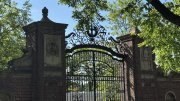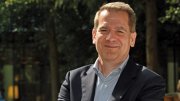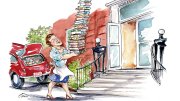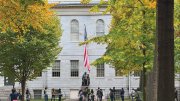Even in elementary school, one suspects, the incursion of technology—tablets, laptops, smartphones—has now rendered all but obsolete students’ venerable end-of-year ditty: “No more pencils/no more books/no more teachers’ dirty looks….”
In the College context, however, a different, and unsettling, notion brings the old lyric to mind. At year-end, The Harvard Crimson helpfully published “Ten Stories That Shaped 2018.” It had been “a momentous year” for the University: as it “welcomed its twenty-ninth president Lawrence S. Bacow, it struggled with numerous challenges including lawsuits alleging discrimination, accusations of sexual harassment levied at prominent affiliates, and an ‘unprecedented’ endowment tax.” Accordingly, the paper examined the stories that “most defined 2018” :
- the Students for Fair Admissions lawsuit alleging discrimination against Asian-American applicants to the College;
- “#MeToo Hits Harvard”;
- the inception of the Bacow presidency;
- social-group opposition to the new sanctions on single-gender organizations;
- University diversity initiatives;
- graduate-student unionization;
- the arrest of a black student and allegations of police brutality;
- the $9.6-billion Harvard Campaign;
- “academic probation” for Harvard College Faith and Action following the group’s pressure on a leader to resign over her same-sex date; and
- Title IX issues.
As any AP statistics student knows, 10 stories is not a large sample. But the selections no doubt reflect both the editors’ news judgment and revealed preferences of readers, including the online, global audience for all things Harvard. Certainly the community itself has a legitimate interest in its new leader, its norms and conduct toward its members, and weighty challenges pressing in on the University from the society beyond.
But one is struck by the nearly total absence of anything academic: the teaching, learning, and research that presumably explain Harvard’s very existence—and students’ rationale for being here. For example, this was the year in which a long-serving dean of undergraduate education handed off his responsibilities to a successor, and she, in turn, shouldered the task of making the entire General Education curriculum ready for students this coming fall. In the past, undergraduates have, with reason, criticized this required part of their curriculum, and they presumably have a stake in how the new one turns out. On a finer scale, they have an interest in how their concentrations are refining courses, tweaking pedagogies, and bringing nascent University intellectual initiatives that cross disciplines and departments (i.e., data science, quantitative biology, and so on) into their own learnin’.
The Crimson touched on many of these issues during the year, of course, but none apparently were top-10 concerns. In a way, this is unsurprising. Although one encounters intensely academic, intellectual students at Harvard, most of them have many other things going on most of the time. Howard Gardner’s research on contemporary campuses is only the latest to find that few students list courses, the curriculum, teaching, or other academic priorities as most on their minds. After all, one of the most famous academic tropes of all time is the late University of California president Clark Kerr’s definition of administrators’ chief problems as “sex for the students, athletics for the alumni, and parking for the faculty.”
And the latter group’s own deliberations have been rather unacademic as well. Faculty of Arts and Sciences monthly meetings are no more representative of the work of 700-plus professors than the Crimson’s list is a comprehensive guide to the work of the University. But during the past half-dozen semesters, it is fair to say that far more time was spent discussing regulation of those unrecognized single-gender social organizations, and matters like re-synching class schedules to accommodate classes in Allston once the engineering and applied sciences complex opens in the fall of 2020, than has been devoted to teaching and learning. The parameters for advanced standing, and the implications for the foreign-language requirement, stand out almost as an anomaly in recent memory. If the professors—who teach and do the research—and their leaders are choosing to set the agenda that way, is it any wonder that the students, who after all are merely passing through, aren’t getting the message about its mission very clearly?
A recent conversation about the composition of the faculty with senior vice provost Judith D. Singer ended up in an unexpected place. She noted that research universities like Harvard are the seedbed for the faculties of the future: the people who make discoveries of fundamental importance and educate leaders who will have a huge impact on society. She also observed that it is by no means certain that students pursuing the surging STEM fields will opt for academic careers (especially given the salaries immediately available in industry and finance). Attracting some, she thought, might depend on professors better conveying both the values of their disciplines and the rewards available to those who invest themselves in the life of the mind.
Beyond that long-term payoff, the professors also might find that students become more invested in their work together, right now. It will take more than that to make a future Crimson top-stories list, but Singer’s idea bears on the larger issue of making teaching, learning, and discovery continuously more central to all the community’s conversations.
~John S. Rosenberg, Editor








